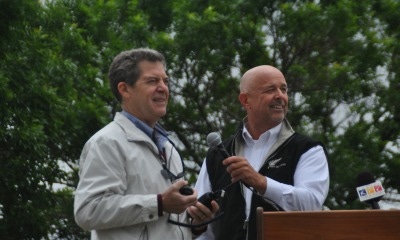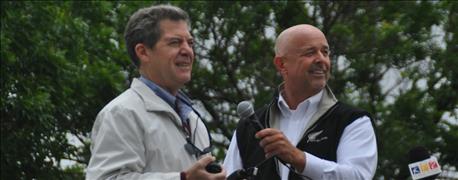
It was gray, cloudy and cold at John Redmond Reservoir's Dam Site Park on Tuesday when Gov. Sam Brownback gave the official order to "let the dredging begin" on the 66th anniversary of the Flood Control Act of 1950 that first authorized the building of the Strawn Dam and Reservoir.
John Redmond Reservoir, re-named in 1958 by an act of Congress to honor the longtime publisher of the Burlington Daily Republican who was among the first to champion a flood control and water conservation project on the Neosho River, is now being revitalized by the dredging project.

LIGHT MOMENT: Gov. Sam Brownback, left, and Kansas Water Office director Tracy Streeter share a light-hearted moment during the offiicial kickoff ceremony for the dredging of the John Redmond Reservoir.
John Redmond supplies municipal water to 19 downstream communities and six industrial users, including Wolf Creek Nuclear Power Plant. It is one of 17 reservoirs in Kansas operated by the Kansas City and Tulsa Districts of the Army Corps of Engineers.
When the drought of 2012 called attention to the fact that it had lost 42% of its storage capacity to silting-in, almost double the original projections of the Army Corps of Engineers, the Kansas Division of Water Resources and the Kansas Water Office responded quickly.
"We realized during that crisis that if the drought had continued at the intensity of the 1950s drought, we would have been out of water and unable to fulfill our responsibility to downstream customers including Wolf Creek," Gov. Sam Brownback said in his remarks during the ceremony.
In 2013, the state got permission for a reallocation of the lake's water level, raising it almost two feet and increasing its holding pool from 55,000 acre feet to 64,000 acre feet.
That reallocation was the first step. The dredging project that officially began on Tuesday was the second step. It will remove about 3 million cubic yards of sediment from the lake and increase the storage capacity by about 1,900 acre feet. It will increase the expected lifespan of the lake by 5 years.
A third step, already under way, is the rehabilitation of upstream land to reduce the amount of sediment entering the lake. That includes streambank stabilization projects and changes in farming practices including change to no-till farming and planting of cover crops.
The $20 million dredging project is being financed by bonds issued by the state of Kansas -- the first time ever that a Corps-owned lake is being dredged in a project not financed at the federal level. The history-making project is being viewed as model for other projects across the country.
The 15-year bonds will be repaid 75% from the state water fund fees and 25% from water marketing customers, primarily Westar Energy, which is a partner in the Wolf Creek power plant.
Brownback said the project is a gesture of gratitude to the previous generation who invested in the original infrastructure and an indication that this generation is willing to "build up our seed corn rather than eating it."
The sediment from the lake bottom being dredged is being pumped via pipeline to five different contained disposal facilities on farmland leased from local landowners who will be able to reclaim the land when the dewatering of the sedimentation is complete within the next five years.
The CDFs have been constructed by removing topsoil from the flat farmfields of the flood plain and building dikes to contain the dredged material, which is about 75% water. As the pumped sediment settles, the water will be returned to the Neosho River. Eventually, the topsoil will be returned to the fields and whole containment area regraded to ensure the natural drainage of the area is restored. The rehabilitation project is expected to take about five years.
"We believe that the farmland will be maintained at its current level of fertility or even improved," said Brad Unruh, project manager of the dredging project with the Kansas Water Office.
The dredging work is being done by Great Lakes Dredge and Dock Company, the largest dredging contractor in the U.S. and a competitor in the world market.
About the Author(s)
You May Also Like






